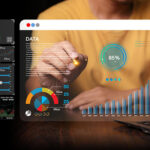DataSemantics introduces Chat with Data, a conversational interface that lets users access insights using natural language—no dashboards or reports needed. Users type questions and instantly get answers, speeding decisions and removing delays. This tool empowers team members at all levels to explore business data easily, boosting data adoption across the organization. It’s a simple, fast path from question to insight—without needing technical skills.
In large enterprises, data should drive decisions—but too often, it doesn’t. Business leaders have questions, but answers take time. Dashboards are complex. Reports pile up. Analysts are overwhelmed.
In fact, over 60% of enterprise data goes unused in decision-making (source). That’s a huge lost opportunity.
Chat with Data fixes this. It makes data instantly accessible through natural language. No dashboards to navigate. No delay. Just type what you want to know, and your data answers back—clearly and visually.
This guide breaks down how it works, where it fits into your enterprise stack, and how its helping teams move faster with confidence.
Table of Contents
Why Conversational Data Interfaces Are Taking Off

Most business intel conversations. Anyone can ask a question in plain English and get real-time answers, drawn directly from your existing intelligence (BI) tools that were designed for analysts. They’re powerful but complex. Business users—like sales heads, marketers, or ops leaders—often rely on others to pull the numbers they need.
Chat with Data changes the equation. It puts the power of BI into everyday data systems.
The result? Faster responses. Fewer delays. And more confident decisions across the board.
How Chat with Data Actually Works

Here’s what happens behind the scenes when someone asks a question:
-
- The system understands the intent of the query using NLP for data analysis
-
- It pulls the relevant data from across your sources
-
- It delivers a response as a summary, chart, or key insight
For example, a sales manager might type, “Show me sales performance in the East region last week.”
Why It’s Better Than Traditional BI Tools

Old-school BI is great—if you’re trained to use it. For everyone else, it creates friction.
With Chat with Data, here’s what changes:
| Traditional BI | Chat with Data |
| Complex tools, training needed | Just ask in plain English |
| You dig through dashboards to find answers | Real-time answers on the fly |
| Limited to analysts | Open to anyone with access |
It’s like going from static dashboards to a live conversation with your data.
What Teams Can Do with It

Think of how many times your teams need quick data:
-
- Sales – Understand product trends across regions
-
- Marketing – Check which campaigns delivered the best ROI
-
- Finance – Compare margins between SKUs or locations
-
- Ops – Track inventory issues, supply chain delays, or fulfilment gaps
A good data visualization chatbot handles these without switching tabs or tools. Just ask, and the insight comes back as a visual or short answer.
This is what makes a real-time analytics chatbot different. It’s not another dashboard—it’s a smarter, faster interface for everyday decisions.
What to Look For in a Chat with Data Platform
When choosing a platform, make sure it can:
Not all “chat with data” tools are built the same. Here’s what truly matters when choosing one:
-
- Understands business language—not just keywords
(You should be able to ask questions the way you talk, not the way data is labeled.)
- Understands business language—not just keywords
-
- Connects to all your data sources in one place (no toggling between tools or digging through systems.)
-
- Returns answers visually—not just rows in a table (think charts, summaries, and snapshots that drive decisions.)
-
- Handles large-scale, enterprise-grade data
(It should be built to scale with your business.)
- Handles large-scale, enterprise-grade data
-
- Respects permissions, roles, and data access rules
(Not everyone should see everything—and that’s how it should be.)
- Respects permissions, roles, and data access rules
-
- Works inside the tools your teams already use (whether it’s Microsoft Teams, Slack, or inside your CRM, it should meet you where you are.)
It should work where your teams already work—whether that’s inside Microsoft Teams, Slack, or embedded in your CRM.
Implementing It in Your Enterprise
Start simple. Here’s how teams successfully roll it out:
-
- Pick one high-impact use case—like sales reporting or campaign performance
-
- Train it on your actual data and terms—so it understands how your business speaks
-
- Pilot with one team—let them use it, test it, and give feedback
-
- Track what questions are being asked—this shows what matters most
-
- Roll out in phases—once it works in one place, expand to others
Done well, Chat with Data becomes part of how your teams operate—not another tool they forget.
Where This Is Headed
This technology isn’t just catching up to BI—it’s redefining it. With business intelligence AI, the next generation of tools won’t wait for questions. They’ll suggest them.
Imagine this: your system flags a sudden dip in revenue in a specific geography—before you even ask.
This is the future of conversational data queries—systems that surface insights on their own, with context and recommendations built in.
And because they’re powered by large language models, they keep learning—getting better at serving your teams over time.
Final Thought
The more accessible your data is, the faster your business moves.
Chat with Data is more than just a nice-to-have—it’s how smart teams are getting ahead. It makes insight instant, decisions faster, and teams more confident.
If you’re trying to make data a part of your daily rhythm—not just your monthly review—it’s worth starting here.









